Capturing this rainbow on our first day in Colorado signaled a stellar start to a magical 10 day trip!
I spotted the rainbow over the shoulder of my sister Ann at her and Paul’s beautiful home in the Estes Park area.
Moving to their back porch I changed my iPhone setting to wide to capture the rainbow in full glory, then enhanced the image using the handy Snapseed app.
Ann snapped this picture of me as we prepared to go to Mass. I was in photographer heaven out West in raw and rugged Colorado and New Mexico. From June 8-17 Alesia and I took a relaxing 460-mile multi-day drive from Estes Park, Colorado to Santa Fe, New Mexico. The ultimate destination and event was my niece Nicole and Tyler’s wedding in Santa Fe.
This post is the first of several documenting our interesting and illuminating trek.
We visited Colorado in August 2022 and I wrote a post that also includes many bird and animal photos.
I wanted to capture the lay of the land, from the many mountain ranges we would see…
…and the often fast-flowing rivers, creeks and streams…
…to the arid geography of southern Colorado and New Mexico.
Wherever we were (remote Romeo, Colorado in the case of this photo), I kept an eye out for birds and land animals knowing I’d likely see some critters we don’t have in South Carolina.
To follow are my captures starting with the nine lifer birds I photographed. These are birds I have never seen nor photographed before.
The first three days of our trip were spent in Glen Haven and Estes Park. This is the view from my parent’s balcony in Estes Park. Not bad!
The elevation in both Colorado communities is more than 7,000 feet,
We also did a mountain drive called Peak to Peak, a scenic highway that we drove about 45 miles from Estes Park south to an old mining town called Nederland.
MOUNTAIN BLUEBIRD- Glen Haven, Colo.
At first I was nonchalant about seeing this bird a few times in Glen Haven near my sister’s home. I thought they were Eastern Bluebirds like I often see in my backyard.
But as I examined these photos more closely I noticed the blue color is a bit lighter or paler than the Eastern Bluebirds back home.
So I went to the bird identification app I purchased several months ago. That’s when I learned of the Mountain Bluebird that is indigenous to this Western part of the country.
The app I use is called Picture Bird. I found it in the App Store. Enter your photo, the app scans it and tells you what it is. It also shows other photos of, in this case, Mountain Bluebirds, and has detailed descriptions about their behavior, range, even life expectancy (6-10 years for this Bluebird).
WESTERN MEADOWLARK- Fort Carson, Colo.
In the early 1970s the Harwood family lived on the Ft. Carson U.S. Army post near Colorado Springs. My father was a major or lieutenant colonel at that time. He would go to Vietnam from here so we moved off post to Colorado Springs for a year until he safely returned (thank God!)
Then and now Fort Carson is home to the 4th Infantry Division.
So we secured visitor passes and found where I used to live, 26 St. Lo Drive. The neighborhood was not called Ute Hill Village when we lived here. Our house was similar in style to the one seen behind the sign.
You also see the big hill in the background with water towers on top. We used to play back there and I recall climbing that hill a few times.
There’s a big sloping field leading to the water tower hill. We rode bikes and mini-bikes back here.
Today there’s a playground in the old backyard area. That would have been fun to have when we lived here!
I spotted this bird while in the field taking shots of the hill. I felt confident I had a lifer!
Western Meadowlark it is!
Years ago I photographed an Eastern Meadowlark in Virginia near my parents former home on the Chesapeake Bay. See that post here.
Seeing a childhood home at Ft. Carson AND scoring a new bird. This day got off to a great start!
BLACK-BILLED MAGPIE- Fort Carson, Colo.
By the Fort Carson front gate Visitor’s Center is a museum. I’ll detail that in a later post.
While checking out the armor display I noticed this bird under a tree in the shade. This is a Black-billed Magpie, another lifer bird for me.
In Amsterdam several years ago I saw and photographed Eurasian Magpies. See my "Birds of the Netherlands" post.
In Snapseed I used the “morning” effect to better see the Magpie.
Magpies are large with a distinctive look. I saw them in a few other places in Colorado and New Mexico.
Two lifer birds at Ft. Carson! A good visit became a great visit!
SPOTTED TOWHEE- Colorado Springs
The day after our Fort Carson visit we went to Colorado Springs to the amazing Garden of the Gods then the nearby Rock Ledge Ranch Historic Site. I will post separately about those neat places.
Rock Ledge Ranch features outdoor depictions and house and building tours about inhabitants from native Indians to early 20th-century residents. This Indian life structure was underwhelming without interpretation (no guide or signage).
But my interest was aroused when Alesia alerted me to this colorful bird. There was a pair of Spotted Towhees first on the crude building then hopping around on the ground.
I knew immediately that this was a new bird for me. It reminds me of the Baltimore Oriole.
I’m so glad to have been able to get these images. Of the nine lifer birds collected on this Western trip, this may be my favorite.
This Spotted Towhee may be a female with its brown head and tail feathers rather than the male’s black coloring that you see in the next photo and previous ones.
A member of the “new world sparrow” family, the Spotted Towhee Is also called the Spotted Rufous-sided Towhee and the Western Rufous-sided Towhee.
Nice to meet such a dapper dresser!
HOUSE WREN- Colorado Springs
Just after the Spotted Towhee encounter at the ranch, I spotted a little head poking out of a tree along the walking trail. I just got this one photo before it disappeared back in the hole.
This is a House Wren, a small bird known to be assertive about securing a hole nest like this one, even taking it from other birds.
As I’m writing this I just realized that I also photographed a House Wren in May during our Mount Auburn Cemetery visit near Boston.
SWAINSON’S HAWK AND BREWER’S BLACKBIRD- Southern Colorado
Could not believe it! I got a “twofer” here- two first-time lifer birds in a single shot!
This was along a remote highway south of Alamosa, Colo. where we had spent the night after our visit to the Great Sand Dunes National Park and Preserve. I'll post separately about that unique place.
I noticed hawks on two power lines about a mile apart. I told Alesia if I see a third I’m going to pull over and take pictures. Sure enough I came upon this scene. Traffic was light so I safely pulled over.
I wouldn’t know until later what these birds are: a Swainson’s Hawk and its antagonist, a Brewer’s Blackbird.
We do not see these birds in the Southeast.
Such a beautiful raptor! The Swainson name comes from William Swainson, a 19th-century British naturalist, taxidermist and bird illustrator. According to All About Birds, Swainson drew this specimen in Canada in 1827. Five other birds are named after Swainson. Talk about being a birder!
This bird in the winter likes to eat grasshoppers and because of this is sometimes called Locust Hawk.
When you are wanting to photograph new birds you have to be ready to drop everything when and wherever you see one. Such was the case in the parking lot at the Residence Inn in Santa Fe (BTW such a great hotel). We were loading the car for our drive to the Albuquerque airport to catch our flight home.
On a nearby power line I saw a few of these birds. My immediate thought was Kingbird as I’ve photographed Eastern Kingbirds in South Carolina and a Western Kingbird two summers ago in the Estes Park, Colo. area.
But turns out this is a new type for me, the Cassin’s Kingbird. You can see the yellow underside that is distinctive to this type of Kingbird.
I followed the bird going back and forth to a nest it has in a telephone pole light crevice. Cassin’s Kingbird is a large tyrant flycatcher native to the American West.
It is named for American ornithologist John Cassin (1813-1869). Cassin wrote several books identifying and describing 194 new bird species. Five birds are named for Cassin.
I was excited to get one last lifer bird before we returned home. But then In Albuquerque…
CLIFF SWALLOW- Albuquerque, N.M.
In Albuquerque, we made a point to see fabled Route 66. It is part of an existing highway so if not for this sign we would not have known we were on it,
We had some time so Alesia and I parked and walked on the bridge.
This is the Rio Grande River. When we were on the bridge looking down at the river I noticed a bunch of birds flying under the bridge frantically. They seemed to have forked tail feathers so I’m thinking Swallows- but what kind? I have photographed Barn Swallows back East.
Make this photo bigger and you see a few black specks that are the birds I was seeing.
From the bridge I was unable to get decent photos of the small fast flying birds. So I told Alesia I wanted to take the path down to the water so I could see where the birds are going (she waited in the car).
This is what I found- dozens of mud nests forged into the underside of the bridge.
This is a Cliff Swallow colony. Pretty incredible. I have seen such avian formations a few times including on a building at Northwestern University, my graduate school alma mater in Evanston, Ill.
In this photo, an adult is in the middle feeding a little Cliff Swallow. To its right, a head is poking out of a mud nest.
The wings are extended somewhat in this photo.
I used my camera’s rapid fire setting to get these shots. The birds move so quickly to the nests then away from them.
A closeup perspective.
I think I’m being watched!
This was quite the little adventure and I’m glad I was rewarded for my effort. There were some homeless people under the bridge in another section and this creepy graffiti in another part.
So there you have my nice collection of nine lifer birds, from Glen Haven, Colo. to Albuquerque, N.M.
OTHER BIRDS
Next I’ll feature other “non lifer” birds spotted during our trip. This House Finch, caught in mid hop or about to land, it appears, was in Santa Fe at the Residence Inn where we stayed.
This House Sparrow was on the same power line as the Cassin’s Kingbird shown previously. I took the photo from the hotel parking lot.
In Taos, N.M. I saw a House Sparrow when we toured the Pueblo village. I’ll post on that interesting place separately.
Waving to a friend?
In Santa Fe we saw a few Common Ravens. I don’t see Ravens in the Charleston area. Crows, yes.
American Crows are smaller than Common Ravens. I spotted this Crow outside Estes Park as we began the scenic Peak to Peak drive to Nederland.
American Crow in Glen Haven.
Here’s a Rock Pigeon. There were a number of these at Garden of the Gods in Colorado Springs. This one I spotted in Taos at the Pueblo village.
The Rock Pigeon’s purple and blue colors are picked up in this image from Garden of the Gods.
A member of the Dove family, Rock Pigeons do like to hang out on rocks, hence their name. They nest in crevices.
Weird closed-eye look!
During our Colorado Peak to Peak mountain drive we pulled over to check out this bridge and creek in the Drake area. It was picturesque enough…
…but the real picture was an American Robin that landed on the bridge with something in its mouth…
…a large juicy worm.
Yum or yuck? Depends on your perspective I suppose.
An American Pekin Duck and Mallard seem to be buddies on the pond in Colorado Springs at the Rock Ledge Ranch Historic Site.
Pekin ducks are derived from Asian birds brought to America in the 1800s.
Canada Geese doing a happy dance at the historic ranch.
A Mallard pair in Nederland, Colo.
MORE ANIMALS
It’s an easy pick which animal excited us the most. You (barely) see it in the background of this photo at Garden of the Gods in Colorado Springs.
Look at the top of the cliff in the middle…
The Rocky Mountain Bighorn Sheep is one impressive animal, especially the male with the curved horns. The males are called Rams.
We saw four or five up on this cliff. There is a sign on the ground indicating their presence so this must be their home for a long time.
The female Bighorn Sheep are called Ewes. They are smaller in size than the male Rams and their horns are smaller and shorter. I believe all the ones we saw are males like this one.
The Ram’s horns can weigh 30 pounds! And how about those big ears?
The animals here must be used to seeing people. This Mule Deer casually walked across the path…
They are common in Colorado. They must be vigilant to not become a meal for coyotes, foxes, badgers and raptor birds.
Mule Deer are common here too. They get their name because of the large size of their eyes, like mules have.
I’m not positive on this one. I think it’s a female Elk. The creamy white rump area is an Elk characteristic. Female Elk are called Cows.
Cottontail Rabbit along a trail at the Rock sledge Ranch Historic Site in Colorado Springs.
I’ll wrap up this post with several barnyard animals we saw while touring the historic ranch.


















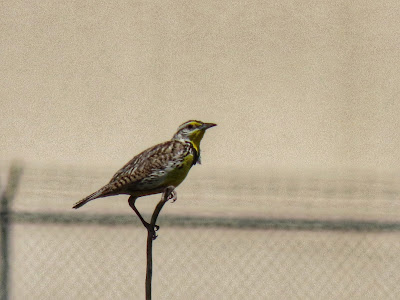


















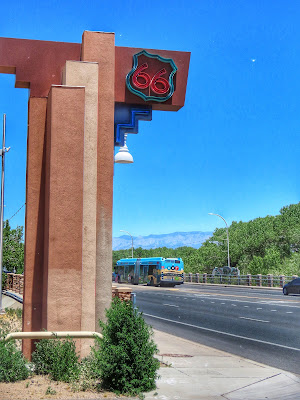






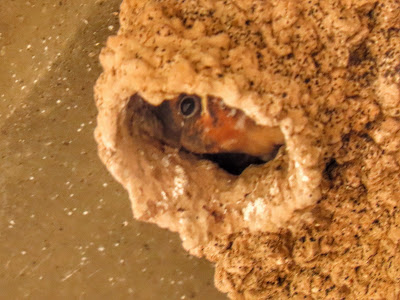











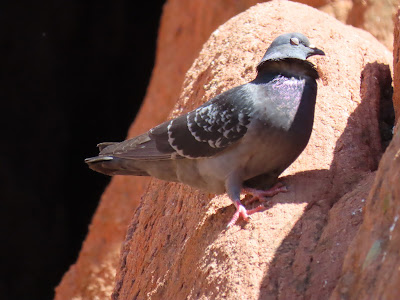

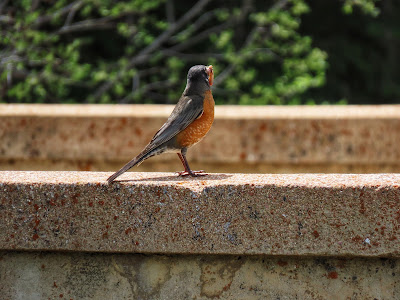



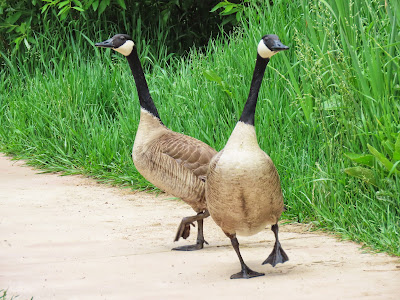

































No comments:
Post a Comment